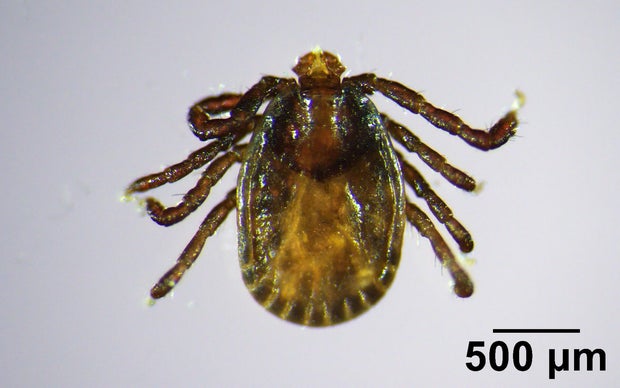An invasive species of tick that has been reported in more than 20 states has been spotted in Maine for the first time, according to officials.
The Asian longhorned tick was first identified in the U.S. in New Jersey eight years ago. The spotting in Maine marks the farthest northeast the tick species has been seen in the country, experts say.
“This discovery underscores the critical importance of continued tick surveillance in Maine,” Griffin Dill, director of the UMaine Extension Tick Lab, a tick surveillance program, said in a news release last month. “While this appears to be an isolated case, we are closely monitoring the situation and coordinating with state and federal partners.”
Dill noted that early detection “is essential to understanding and mitigating the potential risks associated with this species.”
The tick in Maine was submitted through the University of Maine’s tick lab and confirmed by the university and Maine’s agriculture and forestry department, Maine officials said. The tick that was found was not fully grown and couldn’t reproduce, and no additional ticks of the same species were found in the area during subsequent observation.
What is the Asian longhorned tick?
The Department of Agriculture’s Animal and Plant Health Inspection Service describes Asian longhorned ticks as “invasive pests that pose a serious threat to livestock in the United States.”
“They can form large infestations on one animal and spread diseases that impact both animals and people,” it says.
The pests — also called bush, cattle or scrub ticks — are tiny and light brown. Female ticks are able to reproduce on their own, and only one tick is needed to populate an area.
To survive, they attach to and feed on their hosts, which can be humans, pets, wildlife or livestock.
Courtesy of University of Maine Cooperative Extension
Asian longhorned ticks are native to east Asia and are not typically seen in the Western Hemisphere, the agriculture department says. While the first of its kind in the U.S. was initially identified in Hunterdon County, New Jersey, in late 2017, the tick “probably” arrived in the country in or prior to 2010, according to the agriculture department’s inspection service.
It is unknown precisely how or when the tick came to the U.S., “but one thing is certain: it may have entered on domestic pets, horses, livestock or people,” the inspection service says.
Where has the Asian longhorned tick been spotted?
The tick species has been spotted across the Northeast, Midwest and Southeast, and as far west as Oklahoma, a map from the U.S. Department of Agriculture shows.
Earlier this year, the first detection of Asian longhorned ticks was confirmed in Michigan.
Animal and Plant Health Inspection Service/U.S. DEPARTMENT OF AGRICULTURE
What diseases do Asian longhorned ticks carry?
Species of the tick in the U.S. have been discovered to carry Theileria orientalis, which is a pathogen that causes disease in cattle, according to Michigan’s agriculture department.
Asian longhorned ticks are also able to cause diseases such as Rocky Mountain spotted fever, heartland virus and Powassan virus, although they have not been confirmed to carry them in the U.S. outside of a lab setting, according to Michigan’s agriculture department.
Large infestations of the tick can harm animals, and even kill them.
“Unlike other ticks, a single female Asian longhorned tick can produce offspring-1,000 to 2,000 eggs at a time-without mating. That means individual animals could each host hundreds to thousands of ticks,” the Department of Agriculture says. “This can cause great stress on a heavily infested animal and result in reduced growth and production. A severe infestation can kill the animal from excessive blood loss.”
How to protect against Asian longhorned ticks
People can get ticks in their own yards and through activities like dog-walking and gardening. Officials advise people to check their body and clothes after coming inside, and to remove any ticks immediately.
The Centers for Disease Control and Prevention says people can protect against tick bites by treating clothing and other items, like boots and camping gear, with products that have 0.5% permethrin. It also advises using certain insect repellants that are registered with the EPA.
It can also help to keep yards and pastures free of brush and have a border or gravel or mulch to reduce tick habitats, according to officials.
For pets and livestock, regular tick treatments are advised. Officials urge animal owners to check for ticks regularly and consult with veterinarians about prevention methods.
Source link


